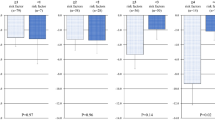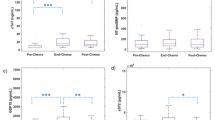Abstract
Cardiomyopathy is a known complication of anthracycline-based adjuvant chemotherapy and is more commonly reported in population-based studies of breast cancer survivors than in clinical trials. This study prospectively evaluated the prevalence of elevated cardiac biomarkers in unselected patients who had been treated with doxorubicin for early-stage breast cancer and the prevalence of reduced LVEF in patients with an elevated biomarker. All participants underwent an examination, symptom inventory, medical record review, and biomarker analysis for BNP, troponin, and plasma and urine NT-proBNP. Patients who had one or more elevated biomarkers were referred for echocardiogram; systolic dysfunction was defined as LVEF less than 55 %. Multivariable logistic regression was used to determine the associations between age, BMI, cumulative dose of doxorubicin, diabetes, hypertension, and left-sided radiation therapy and the risk of reduced LVEF. Among the 269 patients who underwent lab testing (mean age 56 years, mean time since completion of doxorubicin-based chemotherapy 6 years), 192 (72 %) had one or more elevated biomarker. Among the 166 patients who completed an echocardiogram, 11.5 % had a LVEF < 55 %. After adjusting for covariates known to affect cardiac function, multivariable logistic regression revealed plasma NT-proBNP to be the only measured cardiac biomarker associated with systolic dysfunction. There is a relationship between NT-proBNP and the frequency of reduced LVEF in women treated with doxorubicin for curative intent; further study of NT-proBNP as a potential biomarker for subclinical cardiac dysfunction after exposure to anthracyclines is warranted.



Similar content being viewed by others
Abbreviations
- LVEF:
-
Left ventricular ejection fraction
- BNP:
-
Brain natriuretic peptide
- NT:
-
N-terminal
- BMI:
-
Body mass index
References
Sawaya H et al (2011) Early detection and prediction of cardiotoxicity in chemotherapy-treated patients. Am J Cardiol 107(9):1375–1380
Fumoleau P et al (2006) Long-term cardiac toxicity after adjuvant epirubicin-based chemotherapy in early breast cancer: french adjuvant study group results. Ann Oncol 17(1):85–92
Perez EA et al (2004) Effect of doxorubicin plus cyclophosphamide on left ventricular ejection fraction in patients with breast cancer in the North Central Cancer Treatment Group N9831 intergroup adjuvant trial. J Clin Oncol 22(18):3700–3704
Shapiro CL et al (1998) Cardiac effects of adjuvant doxorubicin and radiation therapy in breast cancer patients. J Clin Oncol 16(11):3493–3501
Zambetti M et al (2001) Long-term cardiac sequelae in operable breast cancer patients given adjuvant chemotherapy with or without doxorubicin and breast irradiation. J Clin Oncol 19(1):37–43
Ganz PA et al (2008) Late cardiac effects of adjuvant chemotherapy in breast cancer survivors treated on Southwest Oncology Group protocol s8897. J Clin Oncol 26(8):1223–1230
Doyle JJ et al (2005) Chemotherapy and cardiotoxicity in older breast cancer patients: a population-based study. J Clin Oncol 23(34):8597–8605
Hershman DL et al (2008) Doxorubicin, cardiac risk factors, and cardiac toxicity in elderly patients with diffuse B-cell non-Hodgkin’s lymphoma. J Clin Oncol 26(19):3159–3165
Pinder MC et al (2007) Congestive heart failure in older women treated with adjuvant anthracycline chemotherapy for breast cancer. J Clin Oncol 25(25):3808–3815
Mckee PA et al (1971) Natural history of congestive heart failure—Framingham study. N Engl J Med 285(26):1441
Bart BA et al (1997) Clinical determinants of mortality in patients with angiographically diagnosed ischemic or nonischemic cardiomyopathy. J Am Coll Cardiol 30(4):1002–1008
Trimble EL et al (1994) Representation of older patients in cancer treatment trials. Cancer 74(7 Suppl):2208–2214
Jennens RR, Giles GG, Fox RM (2006) Increasing underrepresentation of elderly patients with advanced colorectal or non-small-cell lung cancer in chemotherapy trials. Intern Med J 36(4):216–220
Hutchins LF et al (1999) Underrepresentation of patients 65 years of age or older in cancer-treatment trials. N Engl J Med 341(27):2061–2067
Ahmed N et al (2007) Role of cardiac troponin I in staging and prognosis of congestive heart failure subjects. Mymensingh Med J 16(1):12–16
Sundstrom J et al (2009) Cardiac troponin-I and risk of heart failure: a community-based cohort study. Eur Heart J 30(7):773–781
Vasan RS et al (2002) Plasma natriuretic peptides for community screening for left ventricular hypertrophy and systolic dysfunction: the Framingham heart study. JAMA 288(10):1252–1259
Redfield MM et al (2002) Plasma brain natriuretic peptide concentration: impact of age and gender. J Am Coll Cardiol 40(5):976–982
Heidenreich PA et al (2004) Cost-effectiveness of screening with B-type natriuretic peptide to identify patients with reduced left ventricular ejection fraction. J Am Coll Cardiol 43(6):1019–1026
Poutanen T et al (2003) Long-term prospective follow-up study of cardiac function after cardiotoxic therapy for malignancy in children. J Clin Oncol 21(12):2349–2356
Palladini G et al (2003) Serum N-terminal pro-brain natriuretic peptide is a sensitive marker of myocardial dysfunction in AL amyloidosis. Circulation 107(19):2440–2445
Wright SP et al (2003) Plasma amino-terminal pro-brain natriuretic peptide and accuracy of heart-failure diagnosis in primary care: a randomized, controlled trial. J Am Coll Cardiol 42(10):1793–1800
Ng LL et al (2005) Community screening for left ventricular systolic dysfunction using plasma and urinary natriuretic peptides. J Am Coll Cardiol 45(7):1043–1050
Hildebrandt P et al (2010) Age-dependent values of N-terminal pro-B-type natriuretic peptide are superior to a single cut-point for ruling out suspected systolic dysfunction in primary care. Eur Heart J 31(15):1881–1889
Betti I et al (2009) The role of N-terminal PRO-brain natriuretic peptide and echocardiography for screening asymptomatic left ventricular dysfunction in a population at high risk for heart failure. The PROBE-HF study. J Card Fail 15(5):377–384
Maisel AS et al (2001) Utility of B-natriuretic peptide as a rapid, point-of-care test for screening patients undergoing echocardiography to determine left ventricular dysfunction. Am Heart J 141(3):367–374
Lang RM et al (2005) Recommendations for chamber quantification: a report from the American Society of Echocardiography’s Guidelines and Standards Committee and the Chamber Quantification Writing Group, developed in conjunction with the European Association of Echocardiography, a branch of the European Society of Cardiology. J Am Soc Echocardiogr 18(12):1440–1463
Ammar KA et al (2007) Prevalence and prognostic significance of heart failure stages: application of the American College of Cardiology/American Heart Association heart failure staging criteria in the community. Circulation 115(12):1563–1570
Redfield MM et al (2003) Burden of systolic and diastolic ventricular dysfunction in the community: appreciating the scope of the heart failure epidemic. JAMA 289(2):194–202
Perez EA, Rodeheffer R (2004) Clinical cardiac tolerability of trastuzumab. J Clin Oncol 22(2):322–329
Tan-Chiu E et al (2005) Assessment of cardiac dysfunction in a randomized trial comparing doxorubicin and cyclophosphamide followed by paclitaxel, with or without trastuzumab as adjuvant therapy in node-positive, human epidermal growth factor receptor 2-overexpressing breast cancer: NSABP B-31. J Clin Oncol 23(31):7811–7819
Swain SM, Whaley FS, Ewer MS (2003) Congestive heart failure in patients treated with doxorubicin: a retrospective analysis of three trials. Cancer 97(11):2869–2879
Solvd Investigators (1992) Effect of enalapril on mortality and the development of heart failure in asymptomatic patients with reduced left ventricular ejection fractions. N Engl J Med 327(10):685–691
Yancy CW et al (2013) 2013 ACCF/AHA guideline for the management of heart failure: executive summary: a report of the American College of Cardiology Foundation/American Heart Association Task Force on practice guidelines. Circulation 128(16):1810–1852
Cardinale D et al (2006) Prevention of high-dose chemotherapy-induced cardiotoxicity in high-risk patients by angiotensin-converting enzyme inhibition. Circulation 114(23):2474–2481
Kalay N et al (2006) Protective effects of carvedilol against anthracycline-induced cardiomyopathy. J Am Coll Cardiol 48(11):2258–2262
Jones SE et al (2006) Phase III trial comparing doxorubicin plus cyclophosphamide with docetaxel plus cyclophosphamide as adjuvant therapy for operable breast cancer. J Clin Oncol 24(34):5381–5387
Giordano SH et al (2012) Decline in the use of anthracyclines for breast cancer. J Clin Oncol 30(18):2232–2239
Acknowledgments
The authors of the study would like to acknowledge the work and efforts of the University of Michigan Clinical Trials Office (CTO) Mobile Clinical Research Unit and the CTO Specimen Core and Processing Lab. In addition, the study would not have been possible without the willing participation of our patients and the efforts by the staff in the breast cancer clinic, especially the physician assistants and nurse practitioners who were dedicated to facilitating patient recruitment.
Conflict of interest
All authors declare that they have no conflicts of interest.
Ethical approval
All procedures performed in the studies involving human participants were in accordance with the ethical standards of the institutional and/or national research committee and with the 1964 Helsinki declaration and its later amendments or comparable ethical standards.
Ethical standards
The experiments performed comply with the current laws of the United States.
Funding
This study was funded by a Pfizer Foundation Fellowship Grant awarded to Dr. Cooney as the PI in support of Dr. Caram’s effort and an intramural University of Michigan Cancer Research Committee Grant awarded to Jeffery Smerage, MD, PhD.
Author information
Authors and Affiliations
Corresponding author
Appendix
Rights and permissions
About this article
Cite this article
Caram, M.E.V., Guo, C., Leja, M. et al. Doxorubicin-induced cardiac dysfunction in unselected patients with a history of early-stage breast cancer. Breast Cancer Res Treat 152, 163–172 (2015). https://doi.org/10.1007/s10549-015-3454-8
Received:
Accepted:
Published:
Issue Date:
DOI: https://doi.org/10.1007/s10549-015-3454-8




